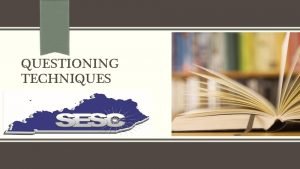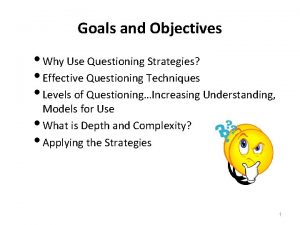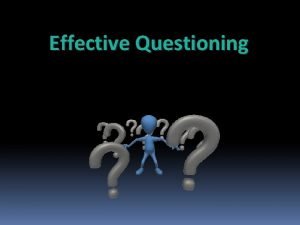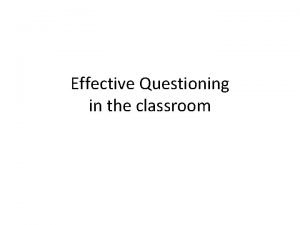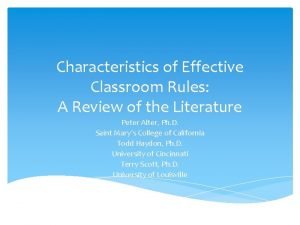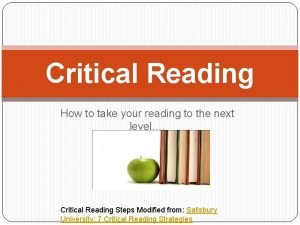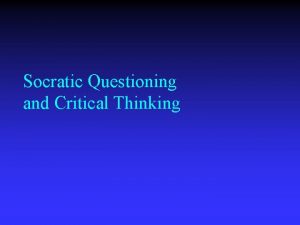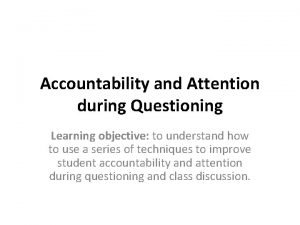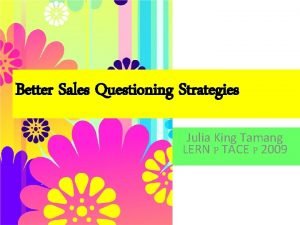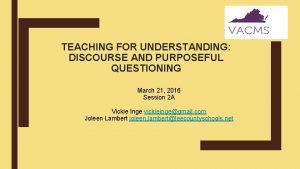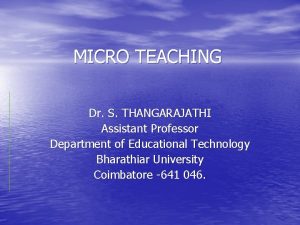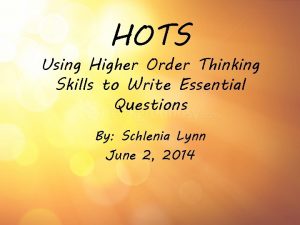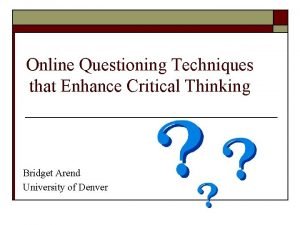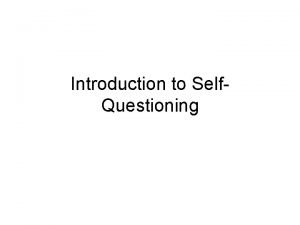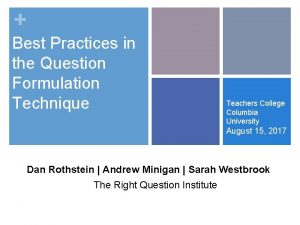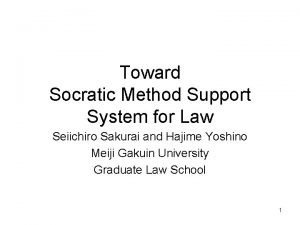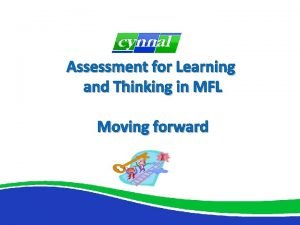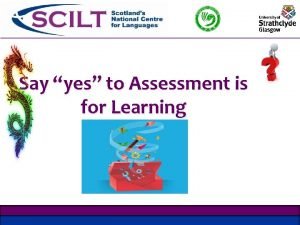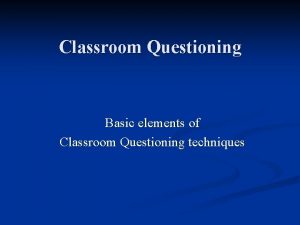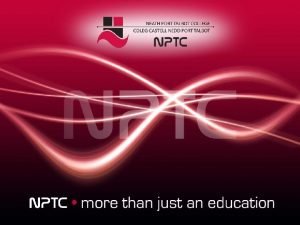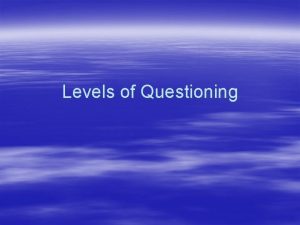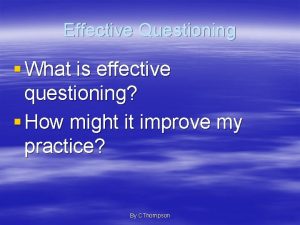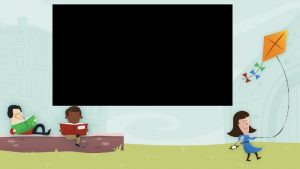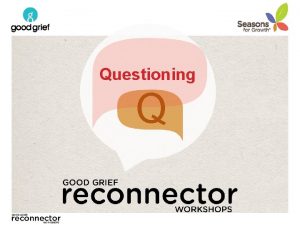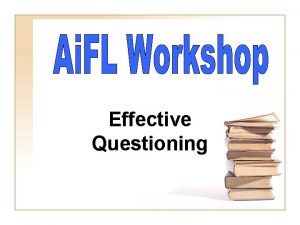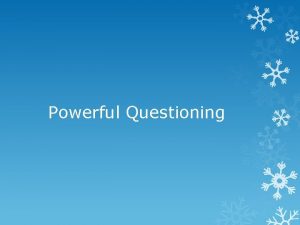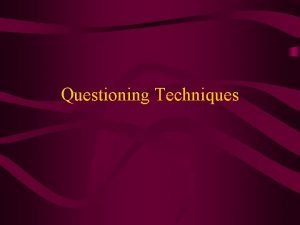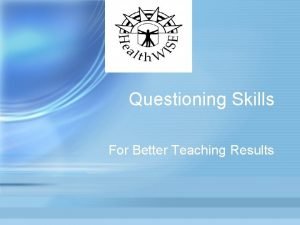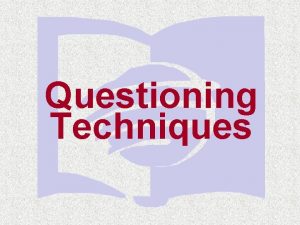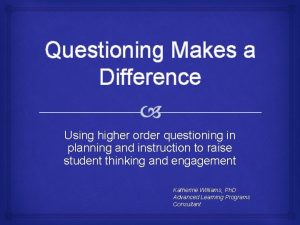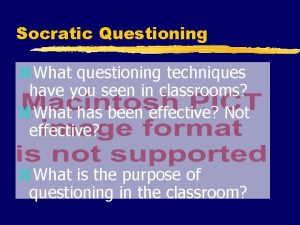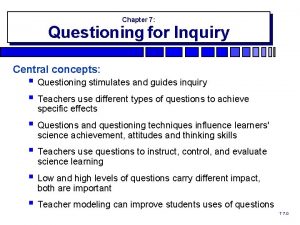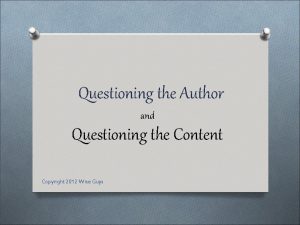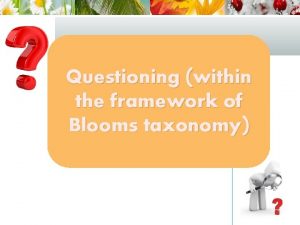Effective Questioning in the classroom The purpose of



























- Slides: 27

Effective Questioning in the classroom

The purpose of Questioning • to interest, engage and challenge pupils; • to check on prior knowledge and understanding; • to stimulate recall, mobilising existing knowledge and experience in order to create new understanding and meaning; • to focus pupils’ thinking on key concepts and issues; • to help pupils to extend their thinking from the concrete and factual to the • analytical and evaluative;

The purpose of Questioning • to lead pupils through a planned sequence which progressively establishes key understandings; • to promote reasoning, problem solving, evaluation and the formulation of hypotheses; • to promote pupils’ thinking about the way they have learned.

Levels of Questions • These levels, in ascending order of sophistication, are: (1) knowledge (2) comprehension (3) application (4) analysis (5) synthesis (6) evaluation. • • More commonly questions are referred to as higher and lower cognitive questions. Lower cognitive questions are those which ask the student merely to recall verbatim or in his/her own words material previously read or taught by the teacher. Lower cognitive questions are also referred to in the literature as fact, closed, direct, recall, and knowledge questions. • Higher cognitive questions are defined as those which ask the student to mentally manipulate bits of information previously learned to create an answer or to support an answer with logically reasoned evidence. Higher cognitive questions are also called open-ended, interpretive, evaluative, inquiry, inferential, and synthesis questions.

Common pitfalls & solutions? Not being clear about why you are asking the question: You will need to reflect on the kind of lesson you are planning. Is it one where you are mainly focusing on facts, rules and sequences of actions? If that is the case, you will be more likely to ask closed questions which relate to knowledge. Or is it a lesson where you are focusing mainly on comprehension, concepts and abstractions? In that case you will be more likely to use open questions which relate to analysis, synthesis and evaluation. Asking too many closed questions that need only a short answer: It helps if you plan open questions in advance. Another strategy is to establish an optimum length of response by saying something like ‘I don’t want an answer of less than 15 words. ’

Common pitfalls & solutions? Asking too many questions at once: Asking about a complex issue can often lead to complex questions. Since these questions are oral rather than written, pupils may find it difficult to understand what is required and they become confused. When you are dealing with a complex subject, you need to tease out the issues for yourself first and focus each question on one idea only. It also helps to use direct, concrete language and as few words as possible. Asking difficult questions without building up to them: This happens when there isn’t a planned sequence of questions of increasing difficulty. Sequencing questions is necessary to help pupils to move to the higher levels of thinking. Asking superficial questions: It is possible to ask lots of questions but not get to the centre of the issue. You can avoid this problem by planning probing questions in advance. They can often be built in as follow-up questions to extend an answer.

Common pitfalls & solutions? Asking a question then answering it yourself: What’s the point? This pitfall is often linked to another problem: not giving pupils time to think before they answer. Build in ‘wait time’ to give pupils a chance to respond. You could say ‘Think about your answer for 3 seconds, then I will ask. ’ You could also provide prompts to help. Asking bogus ‘guess what’s in my head’ questions: Sometimes teachers ask an open question but expect a closed response. If you have a very clear idea of the response you want, it is probably better to tell pupils by explaining it to them rather than trying to get there through this kind of questioning. Remember, if you ask open questions you must expect to get a range of answers. Acknowledge all responses. This can easily be done by saying ‘thank you’.

Common pitfalls & solutions? Focusing on a small number of pupils and not involving the whole class: One way of avoiding this is to get the whole class to write their answers to closed questions and then show them to you together. Some teachers use small whiteboards for this. Another possibility, which may be more effective for more open questions, is to use the ‘nohands’ strategy, where you pick the respondent rather than having them volunteer. One advantage of this is that you can ask pupils questions of appropriate levels of difficulty. This is a good way of differentiating to ensure inclusion. Dealing ineffectively with wrong answers or misconceptions: Teachers sometimes worry that they risk damaging pupils’ self-esteem by correcting them. There are ways of handling this positively, such as providing prompts and scaffolds to help pupils correct their mistakes. It is important that you correct errors sensitively or, better still, get other pupils to correct them. Not treating pupils’ answers seriously: Sometimes teachers simply ignore answers that are a bit off-beam. They can also fail to see the implications of these answers and miss opportunities to build on them. You could ask pupils why they have given that answer or if there is anything they would like to add. You could also ask other pupils to extend the answer. It is important not to cut pupils off and move on too quickly if they have given a wrong answer.

Classroom tactics Creating a climate where pupils feel safe to make mistakes: Using a ‘no-hands’ rule: Probing: Telling pupils the big question in advance: Building in wait time: Research suggests that if the teacher waits about 3 seconds, both before a pupil answers a question and also before speaking after the answer, there are substantial benefits in the classroom. It is likely to: encourage longer answers; encourage a greater number and variety of responses; encourage more confidence and ‘risk taking’; encourage pupils to ask questions in return. Allowing time for collaboration before answering: Placing a minimum requirement on the answer: Saying something like ‘Do not answer this in less than 15 words’ will begin to produce longer responses.

Planning questions If you are going to use questioning to improve what and how pupils learn, you need to be able to formulate different kinds of question: both the closed, product type of question and the open, process type. As you begin to plan in this way, it is a good idea to write down the main questions that you will use in a lesson. The questions you plan will need to be in sequences of increasing difficulty. In addition, you will need to ask questions of different degrees of cognitive complexity in order to challenge pupils and help them to develop their thinking. You will need to consider your objectives for the lesson to ensure that this challenge is built in and that the questions you plan are closely linked to the objectives.

Summary of Research • Questions are planned and closely linked to the objectives of the lesson. • The learning of basic skills is enhanced by frequent questions following the exposition of new content that has been broken down into small steps. Each step should be followed by guided practice that provides opportunities for pupils to consolidate what they have learned and that allows teachers to check understanding. • Closed questions are used to check factual understanding and recall. • Open questions predominate. • Sequences of questions are planned so that the cognitive level increases as the questions go on. This ensures that pupils are led to answer questions which demand increasingly higher-order thinking skills but are supported on the way by questions which require less sophisticated thinking skills. • Pupils have opportunities to ask their own questions and seek their own answers. They are encouraged to provide feedback to each other. • The classroom climate is one where pupils feel secure enough to take risks, be tentative and make mistakes. • There is a ‘no hands’ approach to answering, where the teacher chooses who to ask. • The research emphasises the importance of using open, higher-level questions to develop pupils’ higher-order thinking skills.

Qualities of Good Science Teacher

qualities to become a GOOD science teacher 1. Sincerity of purpose: A teacher should have love for his profession. He should be seriously and sincerely committed to his duties and work. As such be must be on the path of excellence both for his own personal achievements and that of his pupils. 2. Studious and learned: A very desirable quality of a teacher is his taste for reading. He should have the habit of keeping himself in

Cont. . 3. A good communicator of ideas: A teacher should be clear in speech and should be able to pupils with ease and convey his ideas to his blac effectiveness. His k board and sketching should be quite neat, bold and effective. 4. Plain speaking: a teacher nature should Tbehere truthshould lovingnotsbe right A and wrongby ones as wrong. and plain any ambiguity speaking. He must enough courage to say in his thoughts and have saying. the right thing

Cont. … 5. Impartial behaviour and attitude: A teacher should not have any biases of prejudices any kindand towards any of his students. He should not distinguish and discriminate one people from the other and should try to drop all notions of for antagonism by giving a solid proof of his impartial behaviour and attitude towards all of his students. 6. Hard worker and responsible: The teacher should be his own example of

Cont. … 7. Affectionate behaviour: The teacher should create an atmosphere good will, in the matter of dealing with his love and of cooperation students. He should not get irritated on minor faults and mistakes of his pupils but should try to create an environment of mutual trust and affection congenial for proper work and learning. 8. Patience: A teacher should not lose his patience and unnecessarily get disturbed over minor mistakes and shortcomings of

Cont. … 9. Leadership and love for discipline : The teacher must possess the traits of a good leader whom the students mayinhave a genuine faith. He should be able to inspire the students to seek knowledge with sincerity. A disciplined and sincere teacher will be able to inculcate the values of sincerity, discipline and obedience among students. This will channelize the energy of students towards constructive activities. 10. Self confidence: A teacher must have confidence in his

Cont. … 11. Mastery of his subject: A science teacher should have profound knowledge of his subject of study so that he may not cut a sorry figure before his students. He should be able to keep his head high and be able answer all the questions and problems put to him by

Cont. … 12. Knowledge of other subjects: A science should not be an expert knowledge in his subject but haveonly a good working of the should also other related subjects. For example, the physics teacher should have good knowledge of Mathematics and Biology teacher should know much about chemistry in

Cont. … 13. Scientific thinking and attitude: A good science teacher tries to imbibe scientific thinking and attitude in his own to actions thoughts. imbibition of such traits, a attempt provide science. For education in such a way as to science teacher must inculcate in the pupils a habit of testing the validity of certain beliefs and facts by their own independent observations and experimentation. 14. Efficiency in the preparation and use of teaching aids: The science teacher should have sufficient skill and dexterity in improvising and constructing his own aids in teaching of science according to the local needs and situations. Needless to say that he should have full self-

Cont. … 15. Taste of scientific activities: A good teacher should have science taste participating in scientific and love for organizing and ofscientific science museum science club, organising excursions and activities like and science fairs and engaging in the establishment purposeful scientific hobbies. Such activities constitute real education and help in the proper

Cont. … 16. Knowledge of psychology related to science: The teacher should have knowledge of the science of behaviour of his order to handle them effectively teaching students He shouldintry to impart knowledge and skillsintothe then according learning of their process. mental abilities, capacities, interests and attitudes, as well as emotional and social make up. If the teacher is well equipped he may help the students to undergo a battery of intelligence tests a science stream of the curriculum. In this way, if scientific knowledge is imparted to the deserving students it will make the tasks of the teacher and the taught easier. Apart from this the knowledge of other tests and psychological measurement will help the teacher to

Cont. … 17. Knowledge of methods of teaching science: is alsoinessential a science being It trained the latestfor techniques, teacher strategies and for methodology of teaching science including the use of the all type of aid material and developed technology

Cont. … 18. They are able to raise the curiosity level of their students Science is all about discovery and innovation, and unless you’re curious about how and why things work, unless you feel the urge to push through and discover what else can be done or if things can be done differently, science is going to be just another subject for you. A good science teacher should be able to inculcate a sense of curiosity in their students; they must know how to get them to

Cont. … 19. They are flexible in their teaching methods A science teacher must use teaching methods that bring out the desire of to these learn in their students. Some methods may be unorthodox no doubt, but they’re very effective – a visit to the museum to see dinosaur skeletons instead of a theory class that is more boring than illustrative, a class held outdoors to demonstrate the laws of Physics instead of just making their students memorize them, or asking students to

Cont. … 20. They use material outside of the textbook to illustrate The bestfacts science teachers use practical demonstrations or examples in everyday life to illustrate and explain scientific facts. It’s easier to make kids understand how a siphon works when you have a working model that shows how it works; it’s more interesting to mix chemicals together to show the reaction they cause rather than just writing down equations on the board; and it makes more sense to use everyday examples to

Cont. … 21. They are able to tap the potential of students Good teachers know the potential of every child in their class; they don’t talk to the walls or mumble to the blackboard – rather, they make sure that everyone is involved in the classroom. That quiet kid in the corner may be a genius, but his shyness may mask his brilliance. When everyone is involved in the interactions that go on in the class, it allows even those who are reticent to shine and show
 Kathleen cotton classroom questioning
Kathleen cotton classroom questioning Kathleen cotton classroom questioning
Kathleen cotton classroom questioning Questioning and discussion techniques in the classroom
Questioning and discussion techniques in the classroom Purposes of questioning
Purposes of questioning Purpose of questioning
Purpose of questioning Sourima mal
Sourima mal Characteristics of effective classroom rules
Characteristics of effective classroom rules Classroom management elements
Classroom management elements What does it mean to be a critical reader
What does it mean to be a critical reader Socratic questioning
Socratic questioning Agree build challenge questioning
Agree build challenge questioning Sales questioning techniques
Sales questioning techniques What did the author think i already knew?
What did the author think i already knew? Purposeful questioning
Purposeful questioning Micro teaching skills
Micro teaching skills High level thinking skills
High level thinking skills Virtual questioning skills
Virtual questioning skills Self introduction for students in school
Self introduction for students in school Pppb questioning
Pppb questioning Costa level questions examples
Costa level questions examples Higher
Higher Qft questioning
Qft questioning Socratic method is
Socratic method is Questioning in mfl
Questioning in mfl Aifl techniques
Aifl techniques Questioning faith after death
Questioning faith after death What does the bible say about questioning god
What does the bible say about questioning god Reading signposts
Reading signposts
